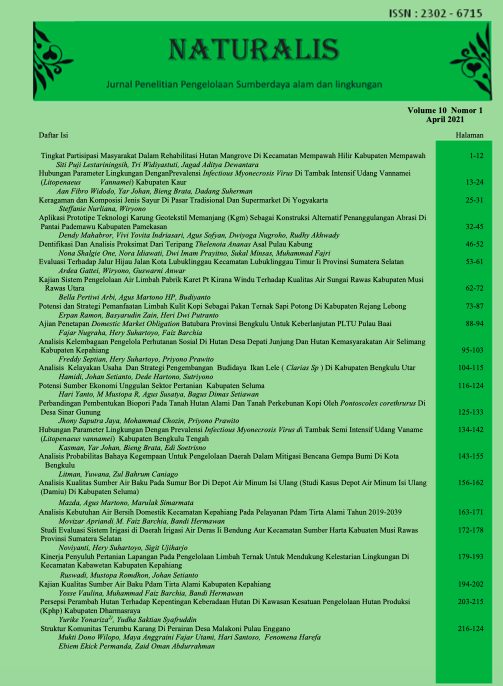KERAGAMAN DAN KOMPOSISI JENIS SAYUR DI PASAR TRADISIONAL DAN SUPERMARKET DI YOGYAKARTA
Abstract
Sayur merupakan sumberdaya hayati yang penting bagi manusia untuk memenuhi kebutuhan gizinya. Dengan keragaman hayati yang tinggi, Indonesia diharapkan memiliki keragaman jenis tanaman sayur asli yang tinggi pula. Penelitian bertujuan untuk menghitung keragaman jenis dan komposisi jenis tanaman sayur segar yang terdapat di enam pasar tradisional dan tiga supermarket di Provinsi Yogyakarta. Data dikumpulkan dengan mencatat jenis sayur yang ada di enam pasar tersebut, kemudian diolah untuk menghitung jumlah jenisnya, menghitung indeks kemiripan jenis antara keenam pasar, dan membandingkan jumlah jenis asli dan introduksi. Dari ke enam pasar dan tiga supermarket diperoleh jenis sayur sebanyak 57, yang terdiri dari 13 suku. Jenis tanaman introduksi berjumlah 38 sedangkan jenis tanaman asli hanya 19. Indeks kemiripan jenis antar pasar maupun supermarket berkisar dari 0,42 sampai dengan 0,9.
Full text article
References
Convention on Biological Diversity. Glos-sary of terms. https://www.cbd.int/invasive/terms.shtml Diakses tanggal 16 September 2020
Hammer O, Harper DAT, Ryan, P.D. 2001. PAST: Paleontological statistics soft-ware package for education and data analysis. Palaeontologia Electronica 4(1): 9pp. http://palaeo-electroni-ca.org/2001_1/past/issue1_01.htm
Martin A R, Cadotte M W, Isaac, M E, Milla R, Vile D, Violle C. (2019). Regional and global shifts in crop diversity through the Anthropocene. PLOS ONE, 14(2), e0209788. https://doi.org/10.1371/journal.pone.0209788
Nisyawati, Aini RN, Silalahi M, Purba EC, Avifah N. 2017. The local knowledge of food plants used by Karo ethnic in Semangat Gunung Village, North Su-matra, Indonesia. AIP Conference Proceedings 1862, 030102 (2017); doi: 10.1063/1.4991206Prihatini, J., Iskandar, J., & Partasasmita, R. (2018). The impacts of traditional homegarden conversion into the com-mercial one: A case study in Sukapura Village of the Upstream Citarum Wa-tershed, West Java, Indonesia. Biodi-versitas 19(5), 1926–1940. https://doi.org/10.13057/biodiv/d190546
Seburanga J L. (2013). Decline of Indige-nous Crop Diversity in Colonial and Postcolonial Rwanda. International Journal of Biodiversity, 2013, 1–10. https://doi.org/10.1155/2013/401938
Sunesi I and Wiryono. 2007. The diversity of plant species utilized by villagers living near protected forest in Kepa-hiang District, Bengkulu Province. In-donesian Journal of Agricultural Sci-ences, Special Edition (3): 432-439
Susanti H. (2015). Studi Etnobotani Sayuran Lokal Khas Rawa di Pasar Martapura. Ziaraah 40 (2): 140-144
Walujo E B. (2011). Keanekaragaman hayati untuk pangan. Makalah disampaikan pada Kongres Ilmu Pengetahuan Na-sional X di Jakarta.
Wardah. 2003. Pemanfaatan keane-karagaman sumberdaya tumbuhan oleh masyarakat Badudy Dalam sekitar Gunung Kendeng Selatan, Kabupaten Lebak, Banten. Berita Biologi 5 (6):679-689
Wikipedia. 2021. Fabaceae. Diakses tgl 2 Januari 2021. https://en.wikipedia.org/wiki/Fabaceae
Wiryono and Lipranto. 2013. The Diversity of locally useful species Batu Ampar village near Bukit Raja Mandara pro-tected forest area in South Bengkulu District. Jurnal Manusia dan Ling-kungan vol 20 no 2:119-127.
Wiryono and Nurliana, S. 2019. Dominasi jenis-jenis tanaman sayur introduksi di pasar sayur tradisional Kota Bengkulu. Life Science Journal of Biology 8 (2): 181-191.
Authors
An author who publishes in Naturalis agrees to the following terms:
Author retains the copyright and grants the journal the right of first publication of the work simultaneously licensed under the Creative Commons Attribution-ShareAlike 4.0 License that allows others to share the work with an acknowledgement of the work's authorship and initial publication in this journal
The author is able to enter into separate, additional contractual arrangements for the non-exclusive distribution of the journal's published version of the work (e.g., post it to an institutional repository or publish it in a book) with the acknowledgement of its initial publication in this journal. The author is permitted and encouraged to post his/her work online (e.g., in institutional repositories or on their website) prior to and during the submission process, as it can lead to productive exchanges, as well as earlier and greater citation of the published work (See The Effect of Open Access).
Submission of a manuscript implies that the submitted work has not been published before (except as part of a thesis or report, or abstract); that it is not under consideration for publication elsewhere; that its publication has been approved by all co-authors. If and when the manuscript is accepted for publication, the author(s) still hold the copyright and retain publishing rights without restrictions. Authors or others are allowed to multiply an article as long as not for commercial purposes. For the new invention, authors are suggested to manage its patent before published. The license type is CC-BY-SA 4.0.
Naturalis is licensed under a Creative Commons Attribution-ShareAlike 4.0 International License.

